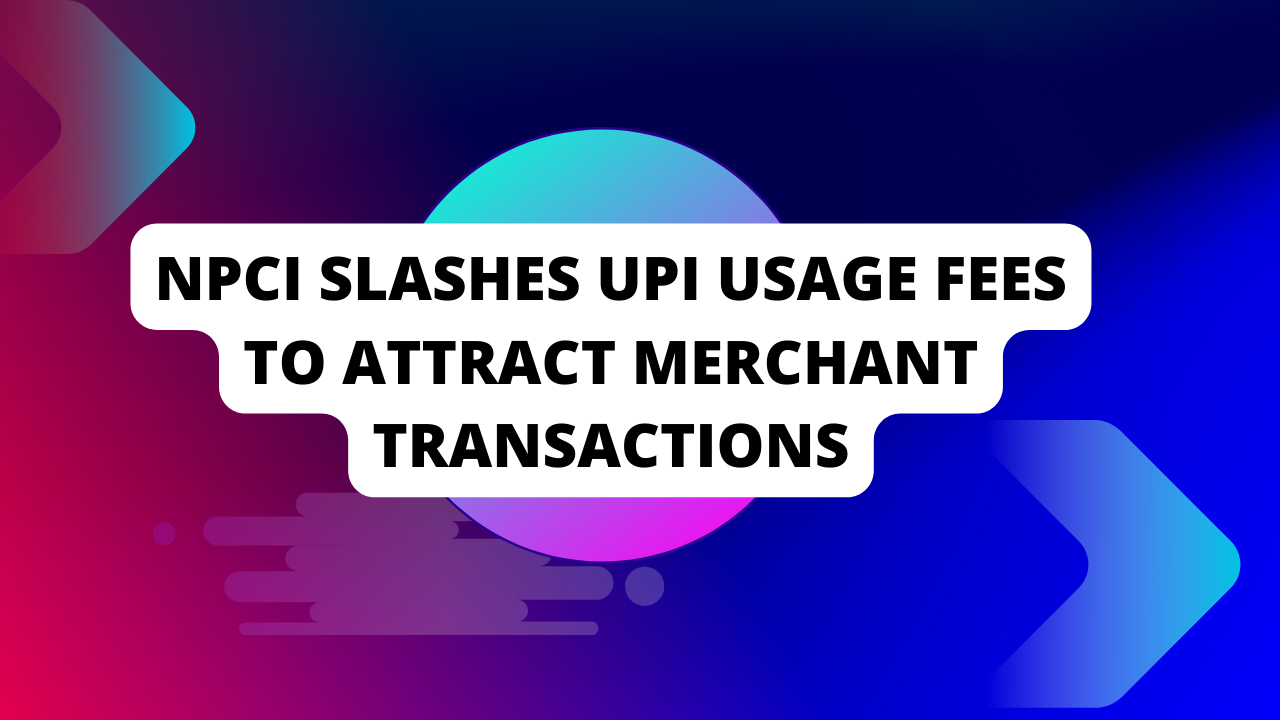The National Payments Corporation of India (NPCI) has taken the decision to reduce the fees associated with Unified Payments Interface (UPI) transactions. This move aims to incentivize greater adoption of UPI among merchants and promote the growth of digital payments in India. By lowering the transaction costs, NPCI aims to make UPI more attractive and financially feasible for merchants of all sizes.
Understanding the Importance of Merchant Transactions:
Merchant transactions play a crucial role in the digital payments ecosystem. Here’s why they are essential:
- Expansion of Acceptance Network: Merchants act as the frontline adopters of digital payment methods. By accepting UPI payments, they contribute to expanding the acceptance network, providing consumers with more options to make cashless transactions.
- Convenience for Consumers: Merchant transactions enable consumers to make quick and secure payments for goods and services. UPI payments offer convenience, as they can be made directly from a bank account using a mobile phone, eliminating the need for cash or card payments.
- Boost to Digital Economy: Increased UPI adoption among merchants contributes to the growth of the digital economy. As more merchants accept UPI payments, the overall volume of digital transactions rises, reducing reliance on cash and driving economic growth.
- Financial Inclusion: Merchant transactions through UPI can help promote financial inclusion. By providing a platform for digital payments, merchants enable individuals who may not have access to traditional banking services to participate in the formal economy.
- Transparency and Efficiency: UPI transactions provide a transparent and efficient way of recording and tracking payments. This reduces the risks associated with handling cash and enables better financial management for merchants.
- Data Insights and Business Growth: UPI transactions generate valuable data that can be leveraged by merchants for business insights. Analyzing transaction patterns and customer behavior can help merchants make informed decisions, optimize their offerings, and drive business growth.
Impact of Reduced UPI Usage Fees on Merchants:
- Cost Savings: Lower UPI usage fees directly translate to cost savings for merchants. With reduced transaction costs, merchants can retain a higher portion of their revenue, especially for businesses with significant UPI transaction volumes.
- Increased Profit Margins: Lower transaction costs can contribute to improved profit margins for merchants. By reducing expenses associated with payment processing, merchants can allocate those savings towards other areas of their business or invest in growth opportunities.
- Incentive for UPI Acceptance: Reduced fees serve as an incentive for more merchants to adopt UPI as a payment method. Merchants who were hesitant to accept UPI payments due to higher fees may now be encouraged to integrate UPI into their existing payment infrastructure.
- Attracting Small and Medium-sized Businesses (SMBs): Lower UPI usage fees can particularly benefit SMBs, as they often operate on tight budgets. The reduced costs make it more financially feasible for SMBs to embrace UPI and expand their digital payment acceptance capabilities.
- Increased Transaction Volumes: With lower transaction costs, merchants may witness an uptick in UPI transaction volumes. Consumers may also be more inclined to make UPI payments if they perceive it as a cost-effective option, leading to increased sales for merchants.
Encouraging Merchant Adoption with Lower Transaction Costs:
- Education and Training: Offer educational resources and training programs to merchants, highlighting the benefits and ease of accepting UPI payments. Provide step-by-step guidance on integrating UPI into their existing payment systems and address any concerns or misconceptions they may have.
- Streamlined Onboarding: Simplify the onboarding process for merchants by reducing paperwork and administrative requirements. Develop user-friendly tools and interfaces that make it easy for merchants to register and start accepting UPI payments quickly.
- Marketing and Promotion: Launch marketing campaigns to raise awareness among merchants about the advantages of accepting UPI payments. Highlight the cost savings, increased customer convenience, and potential for business growth that UPI can bring to their operations.
- Collaborate with Payment Service Providers: Collaborate with payment service providers to offer competitive pricing structures and incentives for merchants who adopt UPI. Develop partnerships that provide value-added services or special benefits to merchants to further encourage adoption.
- Provide Customer Support: Establish dedicated customer support channels for merchants to address any technical issues or concerns they may encounter during the integration or payment acceptance process. Prompt and reliable support can instill confidence in merchants and foster long-term adoption.
Potential Benefits for Consumers and the Digital Payments Ecosystem:
- Enhanced Convenience: Lower UPI usage fees can lead to increased adoption among merchants, resulting in a broader acceptance network. This provides consumers with more options to make UPI payments, promoting convenience and reducing reliance on cash-based transactions.
- Cost Savings for Consumers: Reduced transaction costs can directly benefit consumers by lowering the fees they incur when making UPI payments. This can make digital payments more affordable and attractive compared to other payment methods, encouraging wider adoption among consumers.
- Increased Competition and Innovation: Lower UPI usage fees promote healthy competition among payment service providers, leading to innovative solutions, improved services, and better customer experiences. Consumers can benefit from a broader range of features, incentives, and value-added services provided by payment providers.
- Financial Inclusion: With lower transaction costs, digital payments become more accessible to individuals who were previously deterred by higher fees. This promotes financial inclusion by allowing more people, including those in underserved areas, to participate in the digital economy.
- Economic Growth: A thriving digital payments ecosystem driven by increased UPI usage benefits the overall economy. Digital transactions contribute to transparency, efficiency, and accountability, fostering economic growth and reducing the reliance on cash-based transactions.
Addressing Challenges and Ensuring Security Measures:
- Robust Security Infrastructure: Continual investment in advanced security measures, such as encryption, tokenization, and multi-factor authentication, is crucial to safeguard consumer data and prevent unauthorized access to sensitive information.
- Fraud Detection and Prevention: Employ sophisticated fraud detection systems that can identify and prevent fraudulent activities in real-time. Continuous monitoring of transactions, anomaly detection, and user behavior analysis can help mitigate risks and protect consumers.
- Consumer Education: Educate consumers about safe digital payment practices, such as regularly updating passwords, recognizing phishing attempts, and reviewing transaction details. Promote awareness of security best practices to empower consumers in protecting themselves against fraud.
- Collaborative Efforts: Collaboration between NPCI, banks, payment service providers, and other stakeholders is essential to address security challenges. Sharing information, best practices, and implementing industry-wide security standards can strengthen the overall security posture of the digital payments ecosystem.
- Regulatory Framework: Implement and enforce robust regulations to ensure that all participants in the digital payments ecosystem adhere to strict security standards and consumer protection measures. Regular audits and compliance checks can help maintain trust and integrity in the system.
Collaborative Efforts for a Thriving Digital Payments Landscape:
- Public-Private Partnerships: Foster collaboration between government entities, financial institutions, technology companies, and industry associations to drive the growth of the digital payments landscape. This collaboration can help create a conducive environment for innovation, infrastructure development, and policy implementation.
- Standardization and Interoperability: Establish common standards and protocols to ensure interoperability between different payment systems and service providers. This allows for seamless transactions and enhances the overall user experience for consumers and merchants.
- Knowledge Sharing and Research: Facilitate the exchange of knowledge, best practices, and research findings among stakeholders in the digital payments ecosystem. This sharing of information can drive innovation, address challenges, and promote continuous improvement in security, technology, and regulatory frameworks.
- Consumer and Merchant Education: Collaborate on initiatives to educate consumers and merchants about the benefits, risks, and best practices of digital payments. This includes raising awareness about security measures, fraud prevention, and the convenience and efficiency of digital payment solutions.
- Regulatory Support: Collaborate with regulatory bodies to create a supportive regulatory framework that promotes innovation, competition, and consumer protection. Regular consultations and feedback mechanisms between regulators and industry players can help adapt regulations to the evolving needs of the digital payments ecosystem.
- Infrastructure Development: Collaborative efforts can focus on expanding digital infrastructure, such as internet connectivity and mobile network coverage, to reach underserved areas. This enables a broader population to participate in the digital payments ecosystem, fostering financial inclusion and economic growth.
Conclusion: Driving Economic Growth through Increased UPI Merchant Transactions
The move by NPCI to slash UPI usage fees and the collaborative efforts within the digital payments ecosystem aim to drive economic growth through increased UPI merchant transactions. By reducing transaction costs, merchants can benefit from cost savings, improved profit margins, and increased transaction volumes. This, in turn, promotes UPI acceptance among merchants, enhances consumer convenience, and strengthens the overall digital payments landscape.
Also Read:
- Need Emergency Funds Quickly?
- Investing In Fixed-Income Instruments For High Returns? Is It The Right Strategy?
- SIP or Recurring Deposit: Which One You Should Choose?
- How to Use NFT Marketplaces for Buying and Selling?




